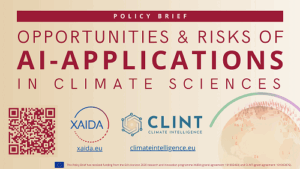The range of possible climates
Extreme events are, by definition, meteorological, localised and punctual. However, climatologists use these individual data to draw conclusions about the state of the present climate and the possibilities of future climate.
“If we consider an event alone we are not studying the climate, we’re in the field of meteorology”, states Davide Faranda, researcher at the Laboratory for Climate and Environmental Sciences (LSCE-IPSL). Head of the ESTIMR team, his work aims to understand climate variations on different scales. As he says, “our goal is to put extreme events into a climate context.” While meteorologists predict the rain and sunshine of following days, the object of study for climatologists do not grant them such a degree of precision. Davide highlights “[they] are not trying to find out whether there will be a cold snap on the 4th of December 2050, but rather how many there will be on average during the decade 2050-2060. Even if the climate is not predictable, the climate statistics are.”
Thus, climate and weather find common ground. By conducting statistical analyses of weather data for decades, climate scientists agree that the frequency of extreme events has clearly increased: “Regardless of the variable studied, the scale or the model chosen, we can see the probability of these events in today’s world is greater than in a world without human impacts,” explains the researcher. To make predictions about the evolution of extreme events, climate scientists constantly keep an eye on data accumulated in the past. This allows them to test the reliability of models, but also to have a point of comparison with the data that is recorded today.
A glance in the rear-view mirror
Despite the improvement in the monitoring of our planet with the advent of satellites, incomplete data from the more distant past leaves a gap that is difficult to fill. “For example, even if we know that the intensity of hurricanes is going to increase it is difficult to predict the evolution of their frequency, because even if we manage to simulate them with climate models, we don’t have good statistics from the past,” explains Davide. In fact, before we had a global view of our planet, it was simply impossible to know about hurricanes that didn’t make landfall. In this case, could the improved detection of recent decades be the reason for this tendency to perceive more extreme events? To Davide, “this bias exists. But in reality we only validate models with very long data series, which come from historical weather stations. Then, for the analyses, we only refer to the models, which are therefore free of this bias.”
Despite some uncertainties, recent improvement in climate models is giving researchers precise information about the future: “For instance, heat waves are going to become more intense because of the global rise in temperatures,” shows Davide, “but there is an additional effect: the slowing down of atmospheric circulation in the summer means that high pressure systems are becoming more persistent over Europe.” The addition of these two phenomena increases the frequency and intensity of these episodes. This is but one example: “These predictions are one of the most important aspects of the latest IPCC report,” says Davide. So, as time goes by and techniques improve, our future is taking shape in the eyes of researchers who know how to decipher our climate past.
Translated from Marion Barbé for IPSL
To go further
Discover Mozaïka: Did you say extreme?
Take a look at the EDIPI Project, a doctoral European project on the study of extreme events, whose French side is coordinated by Davide Faranda, (on Twitter: @edipi_project) and the BOREAS project to gain further insight on how climate change is affecting strong cold spells in Europe
Read The Statistician’s extremes with Mathieu Vrac
And Downscaling models: precious need for the regional level with Davide Faranda






